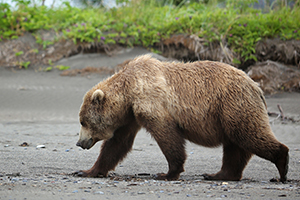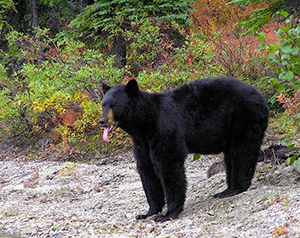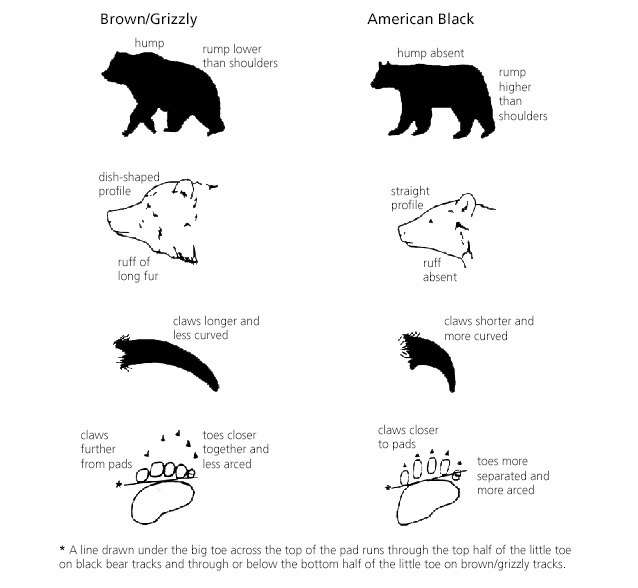Bears are wild animals and can be dangerous. There are a combination of characteristics to look for that can help you identify between black and brown bears. Knowing the difference between the two can help you make safe choices in bear country.
Brown/Grizzly Bears

NPS Photo / Lake Clark National Park and Preserve /Jim Pfeiffenberger
Brown and grizzly are common names for the same species, Ursus arctos; the difference between the two is geographic location, which influences diet, size, and behavior. Those that live in coastal areas of Alaska are called brown bears, while typically inland bears that have limited or no access to marine-derived food resources are often smaller and called grizzlies. Both have the same distinctive body shape described below.
- Distinctive shoulder hump.
- Rump is lower than shoulder hump.
- Face profile appears dished in between the eyes and tip of the snout.
- Ears are short and round.
- Front claws are slightly curved and 2-4 inches longs, depending on how much digging the individual bear does.
- Toes are close together, and form a farily straight line. A line drawn under the big toe across the top of the pad runs through or below the bottom half of the little toe on grizzly/brown bear tracks. Claw marks are often visible in the tracks.
- Brown bears are larger than black bears, standing 3-5 feet at the shoulder when on all fours.
American Black Bears

NPS Photo / Lake Clark National Park and Preserve / J. Mills
- Shoulder lies level or flat with back/lacks shoulder hump.
- Rump is higher than front shoulders.
- Face profile is straight from between the eyes to tip of muzzle.
- Ears are taller and more oval shaped and can appear to be very prominent on the head.
- Front claws are less than 2 inches long and curved.
- Toes are separated and fairly arced. A line drawn under the big toe across the top of the pad runs through the top half of the little toe on black bear tracks. Claw marks do not always show in the tracks.
- Black bears are smaller than brown bears, standing 2 - 3.5 feet at the shoulder when on all fours.
Side-By-Side Comparison of Black and Brown/Grizzly Bear Characteristics

Illustration courtesy of Yellowstone National Park
When trying to identify a bear, do not rely on color and size alone, as they can be misleading. Instead, use tracks and the physical appearance of a bear to determine whether it is a brown/grizzly or American black bear.
Tags
- denali national park & preserve
- glacier bay national park & preserve
- kenai fjords national park
- klondike gold rush national historical park
- lake clark national park & preserve
- bear
- bears
- brown bears
- grizzly bears
- grizzly bear
- brown bear
- american black bear
- american black bears
- black bear
- black bears
- bear id
- bear identification
- bear aware
- bear safety
- alaska
- plants animals and more
- ak1
Last updated: October 26, 2021
